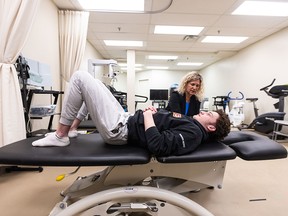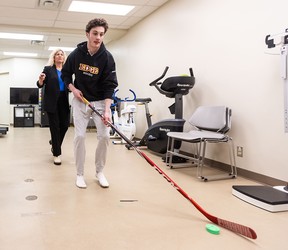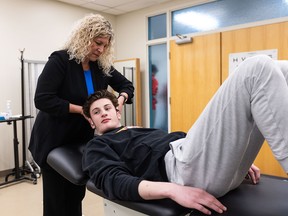‘The old myth of, you know, “sit in a dark room” is not what’s recommended’

Article content
A program run through the University of Calgary is offering cutting edge new research into treatment of concussions.
The faculty of kinesiology, in partnership with Université Laval, is offering a free, seven-week online course starting March 11 coined the Massive Open Online Concussion course. Since 2019, it has helped 14,000 participants better understand concussion prevention, treatment and symptoms.
Advertisement 2
Article content
Article content
The course updates reflect new best practices for concussions, brought on by the Amsterdam International Consensus Statement on Concussion in Sport. Dr. Kathryn Schneider, associate professor in the Sport Injury Prevention Research Centre at U of C, was among more than 114 professionals from around the globe that contributed to the statement.
“This course takes the new information from that statement and shares it in digestible pieces,” said Schneider, who is also a clinician scientist (physiotherapist).
In terms of concussion prevention, Schneider said the use of mouth guards in youth ice hockey and neuromuscular training programs are part of the new program.
Neuromuscular training refers to various types of training, such as agility, aerobic, balance and strength; along with head and neck control exercises, which Schneider said can significantly reduce the risk of concussion.
“It really works on proper technique, so proper movement technique and improved balance,” she said.
Ben Binder suffered a concussion in 2022 while playing hockey. After getting hit from behind, the 16-year-old fell hard, the back of his head striking the ice.
Article content
Advertisement 3
Article content
“I started feeling some symptoms of a concussion, and kind of was telling myself to just push through it,” he said.
He got hit later that game and was pulled out of play.

“I didn’t really think it would affect me that much until it happened, and (then) I knew how serious it could be and how it affects you.”
Schneider helped treat Binder’s concussion symptoms and get him back to 100 per cent.
Binder said that if a concussion is suspected, it’s important to get looked at by a medical professional.
“Rushing (back) into it or not thinking it’ll affect you can have many negative impacts, and probably get worse and keep getting worse — and you’ll be more prone to concussions,” he said.
Recommended from Editorial
Schneider said: “We go into depth in these different areas within the course, and we also share information about new tools to help recognize when a concussion may have occurred.”
One of those tools, Concussion Recognition Tool 6 (CRT6), is meant for use on the sidelines at sporting events, to help recognize concussions and give players the appropriate care.
Advertisement 4
Article content
There are also developments in post-concussion care, notably introducing “symptom tolerated,” no-risk aerobic exercise as early as two days following injury, said Schneider.
“Working within your symptom tolerance and returning to activities of daily living after only 24 to 48 hours of relative rest, and then get moving again, in a safe way, away from risk.”

She said the course was built by more than 40 leaders in the field — clinicians, researchers, sport organizations and sport stakeholders — all sharing content through digestible videos and practical examples.
“One of my favourite parts of the course is the forum discussion, because there’s so many different perspectives,” she said. “We can talk about some of the concepts and how they might apply to people’s individual environments.”
Schneider said a common myth about concussions is that you have to lose consciousness to have one.
“You don’t, less than seven per cent of individuals that have a concussion actually lose consciousness.”
She also said that there’s no one test that can diagnose a concussion — even CT scans or MRIs don’t typically show evidence of them.
“The old myth of, you know, ‘sit in a dark room’ is not what’s recommended following a concussion,” she said.
“In the last 20 years, we’ve really advanced the recommendations around an active approach to rehab.”
Article content





